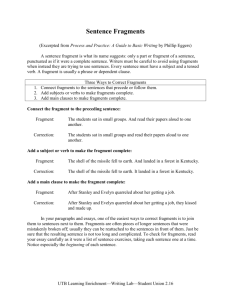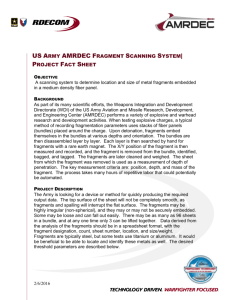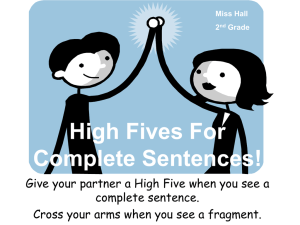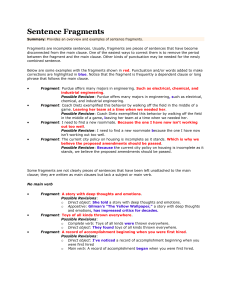Bell Ringer #3 - Fixing Fragments
advertisement
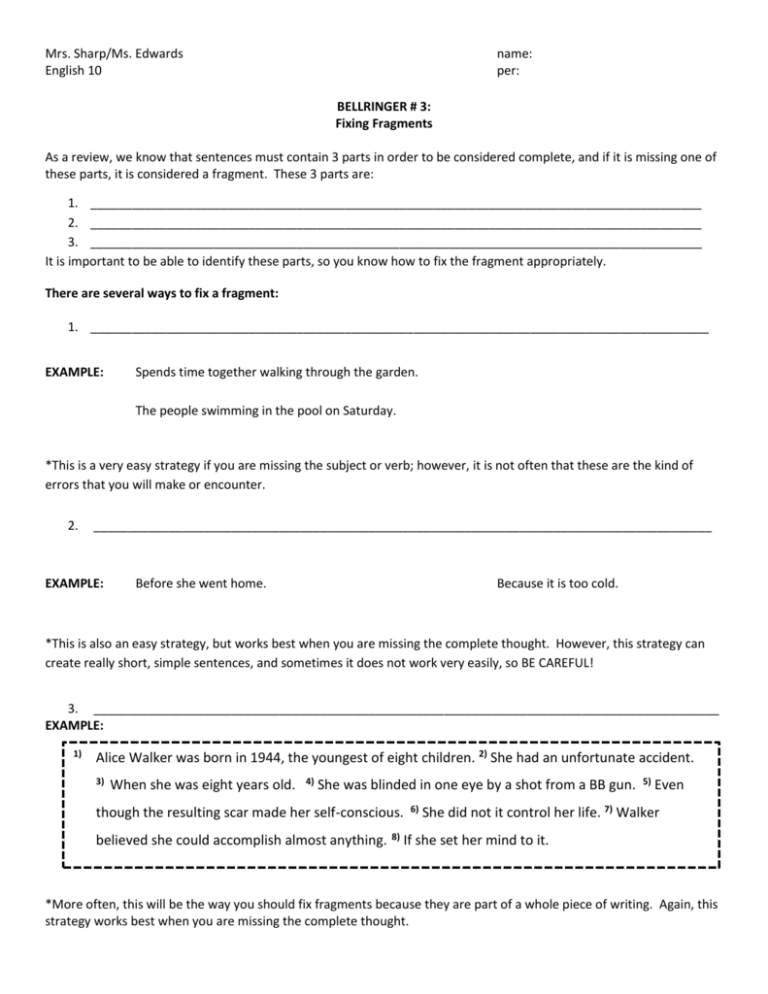
Mrs. Sharp/Ms. Edwards English 10 name: per: BELLRINGER # 3: Fixing Fragments As a review, we know that sentences must contain 3 parts in order to be considered complete, and if it is missing one of these parts, it is considered a fragment. These 3 parts are: 1. _________________________________________________________________________________________ 2. _________________________________________________________________________________________ 3. _________________________________________________________________________________________ It is important to be able to identify these parts, so you know how to fix the fragment appropriately. There are several ways to fix a fragment: 1. __________________________________________________________________________________________ EXAMPLE: Spends time together walking through the garden. The people swimming in the pool on Saturday. *This is a very easy strategy if you are missing the subject or verb; however, it is not often that these are the kind of errors that you will make or encounter. 2. __________________________________________________________________________________________ EXAMPLE: Before she went home. Because it is too cold. *This is also an easy strategy, but works best when you are missing the complete thought. However, this strategy can create really short, simple sentences, and sometimes it does not work very easily, so BE CAREFUL! 3. ___________________________________________________________________________________________ EXAMPLE: 1) Alice Walker was born in 1944, the youngest of eight children. 2) She had an unfortunate accident. 3) When she was eight years old. 4) She was blinded in one eye by a shot from a BB gun. though the resulting scar made her self-conscious. believed she could accomplish almost anything. 8) 6) 5) Even She did not it control her life. 7) Walker If she set her mind to it. *More often, this will be the way you should fix fragments because they are part of a whole piece of writing. Again, this strategy works best when you are missing the complete thought. PRACTICE #1: Read the following paragraphs and identify the fragments by underlining them. Then, decide what you would do to each fragment to fix it by answering the corresponding questions. (1) all of us. (5) At our school, everyone looks forward to Clean-up Day. (3) (2) Each class is excused for the afternoon on Clean-up Day. Members of the student council supervise the work. each will be responsible. (7) (6) Even though it means hard work for (4) Which is observed every spring. Met previously to decide the area of which Some students are equipped with rakes and spades. (8) Some students equipped with brooms and wheelbarrows, which they use to clean up the different areas of the school. 1. How would you fix the first identified fragment (#: ____)? A. B. C. D. Add missing words to it. Connect it to the sentence before it. Connect it to the sentence after it. Delete words. 2. How would you fix the second identified fragment (#: ____)? A. B. C. D. Add missing words to it. Connect it to the sentence before it. Connect it to the sentence after it. Delete words. 3. How would you fix the third identified fragment (#: ____)? A. B. C. D. Add missing words to it. Connect it to the sentence before it. Connect it to the sentence after it. Delete words. 4. How would you fix the third identified fragment (#: ____)? A. B. C. D. Add missing words to it. Connect it to the sentence before it. Connect it to the sentence after it. Delete words. (1) A number of ancient cities have been discovered. surface of the ground. happens. (5) (3) (2) Completely Since no one deliberately buries a city. (4) buried many feet below the People wonder by what process this The explanation is very simple in the case of Pompeii, an ancient Roman city. erupted in A.D. 79, and it poured masses of lava and ashes over the doomed city. unusual. (8) Most buried cities were covered up by a more gradual process. thousands of years. 1. How would you fix the first identified fragment (#: _____) ? A. B. C. D. Add missing words to it. Connect it to the sentence before it. Connect it to the sentence after it. Delete words. 2. How would you fix the second identified fragment (#: _____)? A. B. C. D. Add missing words to it. Connect it to the sentence before it. Connect it to the sentence after it. Delete words. 3. How would you fix the third identified fragment (#: _____)? A. B. C. D. Add missing words to it. Connect it to the sentence before it. Connect it to the sentence after it. Delete words. 4. How would you fix the third identified fragment (#: _____)? A. B. C. D. Add missing words to it. Connect it to the sentence before it. Connect it to the sentence after it. Delete words. (9) (7) (6) Vesuvius However, such a fire Which may have taken Fixing Fragments by Connecting Since this is the way that you will most often fix your fragments because they are part of a larger piece of writing, there are several rules that you need to know: 1. If you connect a fragment to a sentence before it (so the fragment goes at the end), you _________________________________________________________. EXAMPLE: I could not turn in my report. Because I forgot it at home. __________________________________________________________________________________________________ __________________________________________________________________________________________________ 2. If you connect a fragment to a sentence after it (so the fragment goes at the beginning), you _________________________________________________________. EXAMPLE: I could not turn in my report. Because I forgot it at home. __________________________________________________________________________________________________ __________________________________________________________________________________________________ PRACTICE #2: Read the following. Underline each fragment, and make it part of a complete sentence, changing punctuation and capitals where necessary. If it is a complete sentence, mark C. 1. ______ Rubber-soled athletic shoes are called sneakers. Because people can walk very quietly – sneak – in them. 2. ______ Even before 1900. Rubber was used for the soles of leather-topped shoes. 3. ______ Because brown was a popular shoe color. Early sneakers featured brown canvas tops. 4. ______ Sneakers made in Japan became popular in the 1960s. Since they were lightweight. 5. ______ By putting a piece of rubber into a waffle iron, a new pattern was created. Famous University of Oregon track coach Bill Bowerman created this waffle sole pattern. 6. ______ Proving to be more breathable. Nylon fabric was later used for sneaker tops. 7. ______ Since we are highly influenced by our five senses. Companies sell sneakers by appealing to many senses. 8. ______ They seem to say that their brand will make us into talented athletes. PRACTICE #3: Read the following paragraph. Underline the fragments, and revise them by connecting them to a complete sentence. Remember to use the correct punctuation and capitals where necessary. Jaime Escalante became famous for his success in teaching underprivileged students in the inner city high school. Where he was a math instructor. Before he arrived at Garfield High School in Los Angeles. Many studnets were discouraged about learning math. Escalante knew he could reach these students. Whose potential he recognized. It was not easy, but Escalante demanded excellence from his students. Because so many of his students passed the advanced placement exam in calculus. Testing officials became suspicious. They had Escalante’s students take another test. Which they also passed. Where he taught. Escalante’s message was the same: “Believe in your dreams.” YOUR TURN! Turn the following fragments into sentences by fixing them one of the ways that we have practiced. Remember, use the correct punctuation (commas) if you need. 1. because no one is born with good manners ___________________________________________________________________________________________ ___________________________________________________________________________________________ 2. although it may be considered old-fashioned ___________________________________________________________________________________________ ___________________________________________________________________________________________ 3. using good manners ___________________________________________________________________________________________ ___________________________________________________________________________________________ 4. when people are treated with respect ___________________________________________________________________________________________ ___________________________________________________________________________________________





